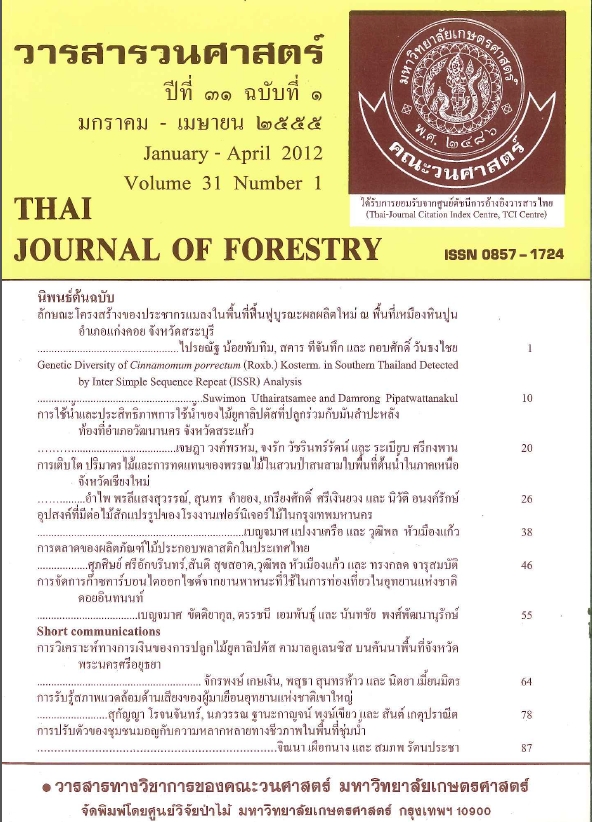การปรับตัวของชุมชนมอญกับความหลากหลายทางชีวภาพในพื้นที่ชุ่มน้ำ
Main Article Content
บทคัดย่อ
มอญเป็นกลุ่มคนดั้งเดิมในภูมิภาคเอเซียอาคเนย์ มีการตั้งถิ่นฐานในสภาพแวดล้อมแบบพื้นที่ชุ่มน้ำ ลักษณะเป็นที่ราบลุ่ม น้ำท่วมขังในฤดูน้ำหลากและบริเวณปากแม่น้ำที่มีระบบนิเวศแบบน้ำกร่อย ชาวมอญจึงมีความสามารถในด้านเกษตรกรรมและการชลประทาน จนส่งผลให้เกิดเป็นถิ่นฐานที่มีความมั่นคงและสามารถพัฒนาขึ้นเป็นอาณาจักรได้ การปรับตัวของชาวมอญที่ผ่านมานับพันปี เป็นการจัดความสัมพันธ์ของชีวิตให้เข้ากับถิ่นที่อยู่อาศัยแบบพื้นที่ชุ่มน้ำที่มีความหลากหลายทางชีวภาพสูง โดยเฉพาะที่ยังปรากฏอยู่ในบริเวณลุ่มแม่น้ำอิระวดีในปัจจุบัน สำหรับชุมชนมอญในประเทศไทย ส่วนใหญ่มีการตั้งถิ่นฐานอยู่ตามริมน้ำ โดยพบหลักฐานที่เก่าแก่ที่สุดอยู่ในบริเวณลุ่มน้ำเจ้าพระยา มอญปากลัด อาศัยอยู่บริเวณปากน้ำเจ้าพระยา อำเภอพระประแดง จังหวัดสมุทรปราการ จากการสำรวจความหลากหลายของพันธุ์ไม้ตามบ้านเรือน พบว่ามีจำนวน 166 ชนิด (species) ใน 70 วงศ์ (family) จำแนกตามลักษณะการใช้ประโยชน์ ได้แก่ การตอบสนองในชีวิตประจำวันของแต่ละบุคคล ความสัมพันธ์ต่อสภาพแวดล้อมและผู้คนในชุมชน และความสัมพันธ์ด้านความเชื่อและสิ่งที่อยู่เหนือธรรมชาติ โดยนำมาใช้เป็นสัญลักษณ์ในการสื่อความหมายเพื่อผูกสัมพันธ์ผู้คนในพื้นที่เข้าไว้ด้วยกัน ควบคู่กับสถานการณ์ ณ ปัจจุบัน ที่โลกกำลังประสบกับปัญหาทางธรรมชาติและสังคม ที่เปลี่ยนแปลงอย่างรุนแรงและรวดเร็วมากขึ้น การมองย้อนกลับไปเรียนรู้อดีต เรียนรู้ความสัมพันธ์ของชีวิตกับถิ่นที่อยู่อาศัย อาจจะเป็นแนวทางที่เป็นคำตอบในสิ่งที่กำลังจะเกิดขึ้นในอนาคตอันใกล้นี้
คำสำคัญ: การปรับตัว มอญ พื้นที่ชุ่มน้ำ พันธุ์ไม้ พระประแดง
Downloads
Article Details

อนุญาตภายใต้เงื่อนไข Creative Commons Attribution-NonCommercial-NoDerivatives 4.0 International License.
ข้าพเจ้าและผู้เขียนร่วม (ถ้ามี) ขอรับรองว่า ต้นฉบับที่เสนอมานี้ยังไม่เคยได้รับการตีพิมพ์และไม่ได้อยู่ในระหว่างกระบวนการพิจารณาตีพิมพ์ลงในวารสารหรือสิ่งตีพิมพ์อื่นใด ข้าพเจ้าและผู้เขียนร่วม (ถ้ามี) ยอมรับหลักเกณฑ์และเงื่อนไขการพิจารณาต้นฉบับ ทั้งยินยอมให้กองบรรณาธิการมีสิทธิ์พิจารณาและตรวจแก้ต้นฉบับได้ตามที่เห็นสมควร พร้อมนี้ขอมอบลิขสิทธิ์ผลงานที่ได้รับการตีพิมพ์ให้แก่วารสารวนศาสตร์ คณะวนศาสตร์ มหาวิทยาลัยเกษตรศาสตร์ กรณีมีการฟ้องร้องเรื่องการละเมิดลิขสิทธิ์เกี่ยวกับภาพ กราฟ ข้อความส่วนใดส่วนหนึ่ง หรือ ข้อคิดเห็นที่ปรากฏในผลงาน ให้เป็นความรับผิดชอบของข้าพเจ้าและผู้เขียนร่วม (ถ้ามี) แต่เพียงฝ่ายเดียว และหากข้าพเจ้าและผู้เขียนร่วม (ถ้ามี) ประสงค์ถอนบทความในระหว่างกระบวนการพิจารณาของทางวารสาร ข้าพเจ้าและผู้เขียนร่วม (ถ้ามี) ยินดีรับผิดชอบค่าใช้จ่ายทั้งหมดที่เกิดขึ้นในกระบวนการพิจารณาบทความนั้น”


